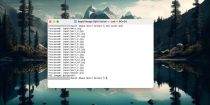Rapid Image Splitter PHPRapid Image Splitter PHP
Rapid Image Splitter: Split multiple images swiftly with precision, simplifying your image processing tasks.Rapid Image Splitter PHP
Rapid Image Splitter: Split multiple images swiftly with precision, simplifying your image proces...
Overview
Rapid Image Splitter is a versatile PHP script designed for efficient and automated image processing. This powerful tool allows you to effortlessly split and organize multiple images into smaller, grid-based parts, enhancing productivity and saving valuable time. With its intuitive features, such as dynamic output directory creation, error handling, and input validation, Rapid Image Splitter ensures a seamless image processing workflow. Whether you're looking to divide images for various creative projects or streamline your batch image processing tasks, this script is your go-to solution. Experience the benefits of automation, consistency, and organization in your image processing endeavors with Rapid Image Splitter.
10 Best use cases of this Image Splitter:
- Image Puzzle Generation: Rapid Image Splitter can be used to create image puzzles by splitting a single image into smaller pieces. This is great for creating interactive and engaging puzzle games on websites or mobile apps.
- Mosaic Art Creation: Artists and designers can utilize Rapid Image Splitter to break down a large image into smaller tiles, which can then be used to create stunning mosaic art pieces. This is a unique and creative way to transform images into captivating visual artworks.
- Image Compression Testing: Developers and quality assurance teams can use the script to divide images into smaller parts for testing image compression algorithms. This helps in optimizing image compression settings for web performance and file size reduction.
- Data Augmentation for Machine Learning: In machine learning and computer vision projects, Rapid Image Splitter can assist in data augmentation by creating additional training data from existing images. It can split images into smaller parts and apply transformations like rotation or cropping to diversify the dataset.
- Poster Printing: When preparing images for large poster prints, this script can be employed to divide the original image into smaller, printable sections. This ensures that each part of the poster can be printed separately and later assembled to create a cohesive large-scale print.
- Educational Content Creation: Teachers and educators can use Rapid Image Splitter to create educational materials. For instance, they can split historical maps, artwork, or diagrams into smaller sections for classroom presentations or study aids.
- Image Analysis and Processing Research: Researchers in image analysis and processing can utilize this script to preprocess and segment images for various experiments and studies, facilitating their research efforts.
- Customizable Content Creation: Content creators can use the script to generate customized content by mixing and matching smaller image segments. This can be applied in creating unique social media posts, banners, or promotional materials.
- Geographical Mapping: Geospatial applications can benefit from Rapid Image Splitter by dividing large satellite or aerial images into smaller tiles, simplifying the rendering and display of maps on web platforms.
Features
- Input Validation: The script checks if the input directory ("input" in this case) exists and provides an error message if not found. This helps users ensure that they have placed their images in the correct location.
- Output Directory Creation: The script creates an output base directory ("output" in this case) if it doesn't already exist. It sets appropriate permissions (0777) to ensure the directory can be written to.
- Iterative Processing: It iterates through the files in the input directory, skipping hidden files and directories (those starting with a dot '.'), and processes each image individually.
- Dynamic Output Directory Creation: For each image, it dynamically creates a new directory within the output base directory ("Image1," "Image2," etc.) to store the processed images.
- Image Copying: It copies the original image to the respective output directory and names it "main.jpg," preserving the original image for reference.
- Image Splitting: The script divides each image into smaller parts following a specified grid pattern and saves them with unique names in the output directory.
- Error Handling: The script handles various potential errors gracefully, such as failed directory creation, copying, and image splitting, and provides informative error messages.
Requirements
PHP 5.6+, 7.xx, 8.xx
File System Permissions
ImageMagick
Instructions
Step 1: Prerequisites
Before you begin, ensure that you have the following prerequisites in place:
- PHP is installed on your system, and you know how to execute PHP scripts from the command line.
- You have ImageMagick installed and accessible via the command line (you can run
magickcommands).
Step 2: Download and Prepare the Script
- Download the "Rapid Image Splitter" script and save it to a directory on your system.
- Create an "input" directory in the same location as the script. Place the images you want to process into this "input" directory.
- Make sure you have write permissions in the directory where the script is located, as it will create an "output" directory to store the processed images.
Step 3: Run the Script
- Open your terminal or command prompt.
- Navigate to the directory where the script is located using the
cdcommand. For example:shellCopy code cd /path/to/script-directory
- Execute the script by running the following command:
shellCopy code php script-name.php
Replacescript-name.phpwith the actual name of the script file you downloaded.
Step 4: Monitor the Script Execution
The script will start processing the images in the "input" directory and splitting them into smaller parts. It will create a new "output" directory and organize the processed images into subdirectories named "Image1," "Image2," and so on.
As the script runs, it will display messages in the terminal indicating the progress of each image's processing.
Step 5: Check the Processed Images
Once the script completes its execution, you can navigate to the "output" directory to find the processed images. Each subdirectory will contain the split parts of the corresponding input image, along with the "main.jpg" file, which is a copy of the original image for reference.
Step 6: Additional Customization (Optional)
If you want to customize the script's behavior, you can edit the script file itself. For example, you can change the grid pattern for image splitting by modifying the ImageMagick command within the script.
Step 7: Troubleshooting
If you encounter any issues or errors during the script's execution, carefully read the error messages in the terminal. These messages will provide information about the problem, such as missing input images or permission issues. Address any errors accordingly.
Other items by this author
| Category | Scripts & Code / PHP Scripts / Multimedia / Image |
| First release | 13 January 2024 |
| Last update | 13 January 2024 |
| Software version | PHP 7.0, PHP 7.1, PHP 7.2, PHP 7.3, PHP 7.4, PHP 8.0, PHP 8.1, PHP 8.2, PHP 5.x, PHP 5.6 |
| Files included | .php, .html |
| Tags | image processing, pieces, image split, split image, image into grid, pieces of image |













